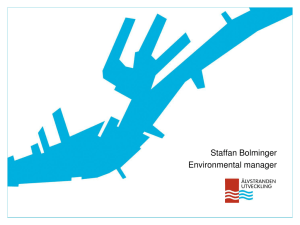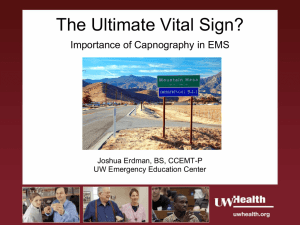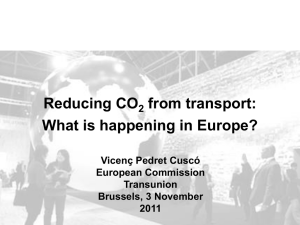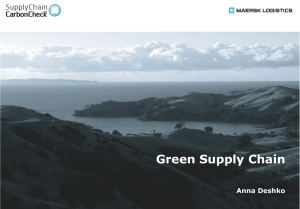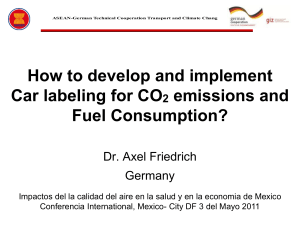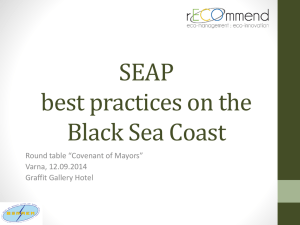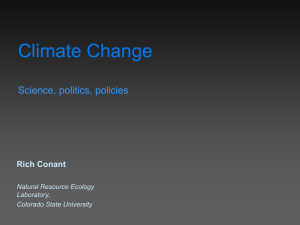the presentation of this lecture - bivec
advertisement
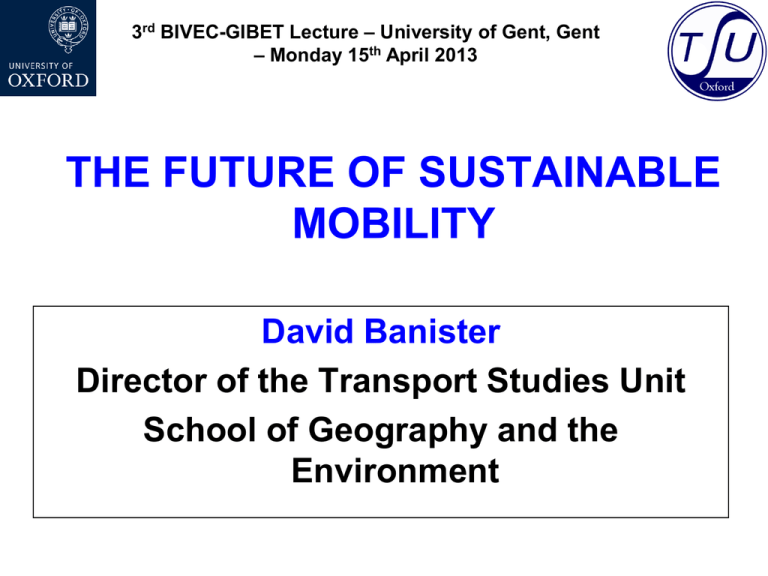
3rd BIVEC-GIBET Lecture – University of Gent, Gent – Monday 15th April 2013 THE FUTURE OF SUSTAINABLE MOBILITY David Banister Director of the Transport Studies Unit School of Geography and the Environment 1. Global Perspective 1. Transport brings enormous benefits – globalisation, travel and trade 2. Totally dependent on oil – uses 61% global oil (over 71% in the EU27 3. Major contributor to CO2 emissions – about 25% IPCC 2007: Figure 5.4: Historical and projected CO2 emission from transport by modes, 1970–2050 Source: IEA, 2005; WBCSD, 2004b. Limited Action in Transport EU27 Growth in Transport Emissions 1990-2009 – MtCO2e 1990 1995 2000 2005 2008 951.1 1029.3 1161.8 1259.6 1224.6 16.5% 19.0% 21.8% 23.1% 25.0% +29% +8.5% Source: EC (2011) EU Transport Statistical Pocketbook 2012 2. Social Science - Thinking Review: Five basic strategies Acceptance of complexity – but main aim has been decarbonisation through a mixture of: 1. Transport technologies – hybrids, EVs, efficiency, weight, fuels 2. Price of carbon, fuel prices and cap and trade approaches – pricing the negative externalities 3. Infrastructure investment – in low carbon transport including buses, walking and cycling, and also HSR – integration through densification and TODs 4. Soft measures and behavioural change – attitudes, lifestyles, norms and the values placed on the environment and decarbonisation 5. Institutions and structures governing transport systems – rules and regulations – and role of different agencies Schwanen,T, Banister, D and Anable, J (2011) Scientific research about climate change mitigation in transport: A critical review, Transportation Research A 45: 993-1006 Methods: 1. Quantitative empirical studies – use of statistical methods, including regression and discrete choice modelling – short term – trend based 2. Scenario approaches – projective or forecasting methods and prospective scenarios – often over a longer time horizon – also backcasting approaches for more normative futures – could be trend breaking Based mainly on positivistic epistemologies – with the hierarchical perspective of the expert determining knowledge, relevance, reasoning and assumptions – limited input from ‘outsiders’ (Hickman, 2009a; based on Organisation for Economic Co-operation and Development, 2000) Paradigms, normal science and understandings Three dimensions of practical understanding 1. Prepossession and familiarity – background understanding 2. Preview and problem – how to deal with a problem 3. Preconception and solution – ways of resolution These concepts help us to understand the development of transport studies – multiple path dependencies can be found Comment: Huge amount of research has been carried out – vibrant and varied 1. Decarbonisation of transport a massive task – need to combine means and measures to target multiple elements of the system 2. Overwhelming focus on technological solutions 3. The ‘logic of provision’ prevails – better infrastructure means a shift will take place 4. Market based approaches dominate – carbon emissions are commodified and pricing is seen as the solution 5. Research emphasising behavioural change is gaining in popularity 6. Quantitative methodologies – positivism prevails – but participatory and qualitative methods are increasingly used Conclusion: Path dependency – the experiences in the past development of transport studies pattern the responses to new stimuli – rather than new thinking. 3. Social Science - Contributions 1. Reinforcement of the techno-economic focus through part dependency and the belief in Neo Liberalism and Ecological Modernisation 2. These approaches are useful – but only give part of the picture 3. Need to extend the discourse – CC mitigation in transport must be understood as a multiplicity of context-dependent social processes 4. A much wider range of approaches – ethnographies, participatory and action research – and different epistemological frameworks Socio technical transitions: micro level Practice theories: behaviour is seminiche – influenced by the broader conscious (routinised) and has 4 landscape and the intermediate regime elements Transition seen as a co-evolutionary process with many actors spanning a period of time a) Material a) Longitudinal studies of past transitions c) Symbolic b) Present day niches in the near future d) Affective b) Procedural Schwanen, T, Banister, D and Anable, J (2012) Rethinking habits and their role in behavioural change: The case of low carbon mobility, Journal of Transport Geography 24: 467-535 Social Sciences – as generators of new thinking and as initiators of new solutions Two propositions – not mutually exclusive but different pathways to meet the objective of sustainable mobility – and path breaking 1. Technological futures 2. Rethinking urban mobility 4. Zero Carbon Mobility? Technological Futures - Masdar 20 miles from Abu Dhabi No carbon no waste – covers an area 6 km2 with a residential population of 6,000 (45,000 by 2020) – solar energy – no cars – rail access to Abu Dhabi – pedestrian scale – natural cooling from 40C to 30 C Original design for a personal rapid transit system – podcars – to operate automatically on a driverless system between about 100 stops – with about 3000 vehicles to cater for 135,000 daily trips 5. Rethinking Urban Mobility Car as a compromise – not good at doing what it ought to do: 1. Major investment – buying a car 2. Value halves over two years – asset or liability 3. Multi functional – 4 people when normally only one 4. Energy inefficient – weight 1200kg to carry 75 kg 5. Huge amount invested in the support system 6. Dominates the urban environment in many cities 7. Substantial environmental and social costs But symbolic of success, image and status? Opportunity to Rethink the Car 1. Shrink the car – less parking, more open space – light weight materials 2. New ownership patterns – sharing and leasing 3. Service based transport 4. Efficient public transport 5. Potential for small, slow electric vehicle – not as a replacement but a new mode of transport 6. Collaborative Consumption and Changing the Dynamic Lifestyles – buy-usetrash lifestyle – needs to change – sharing renting borrowing – circular economy Resources and public finance embedded in the system – to promote higher levels of mobility. Better use of existing capacity – space as a resource European cities – high levels of walking and cycling – over 50% of trips – and public transport 20-30% Freiburg Andrea Broaddus, 2007 Levels of cycle use in different countries – John Pucher and Ralph Buehler (2008 and 2012) Amsterdam Manfred Breithaught, 2007 Groningen http://www.youtube.com/watch?v=lfoSq08I6-g http://files.theecologist.org/resources/carbonfootprints.html 7. City transport in a post carbon society – the greenprint 1. Slower travel to improve quality of life, to contribute to CO2 reductions, and to increase safety and health benefits 2. Travel time savings linked to travel time reliability and reasonable travel times – creative use of time when travelling 3. Smaller vehicles – cars and vans – less parking and more open and green space – reallocation of space to cyclists and walkers – use of active transport modes for at least 50% of trips 4. Local pollutants have a direct effect on health and quality of life – zero or low emissions zones 5. Promote active travel – cycling and walking. 66% of adults do not get enough exercise 6. Investment in clean efficient public transport 7. Potential for a small, slow, clean, shared or leased vehicle – a new mode of transport Hangzhou, China Karl Fjellstrom, 2006 8. Transport Governance Evolutionary Approaches – Unruh (2000) 1. End of pipe: system left intact, but treat externalities 2. Continuity measures: incremental change and innovations to maintain the existing system 3. Discontinuity measures: radical innovation and transition Transport related discourses heavily influenced by scientific and expert understandings – desire to accommodate additional demand for transport – the issue of capacity Unruh, GC (2000) Understanding carbon lock in, Energy Policy 28:817-30. San Francisco, Felix Kramer, 2009 Implementation Current system does not encourage innovation or open and collaborative actions – but is fragmented – making integration difficult – institutional lock-in 1. Participatory approaches – communicative planning, with less emphasis of technocratic processes – greater clarity of responsibilities and powers 2. Specialisation and compartmentalisation – mitigates against coordination and holistic approaches – wide range of interests and division of powers - ineffective Need for multi level perspectives – niches, regimes and landscapes – and transition pathways – timing important – disruption rather than reinforcement – with the innovation having a competitive or symbiotic relationship with the regime – important role for public policy – to create transition arenas – exchange knowledge, learning, experimentation – to create broad public coalitions of support Kemp, R, Avelino, F and Bresser, N (2011) Transition management as a model for sustainable mobility, European Transport 47:25-46 Global Governance 1. Debates over responsibilities – developed v developing 2. Complexity and contestability – aviation and maritime From production accounting – exporting emissions – to consumption based accounting to allocation emissions to end users Land transport Air transport Shipping Global Total 2008 2050 6.6 Gt CO2 (22%) 0.730 Gt CO2 (2.2%) 1 Gt CO2 (3.1%) 29.381 Gt CO2 3.2 – 3.6 Gt CO2 (20-22%) 2.4 – 3.2 Gt CO2 (15-20%) 2.4 – 3.6 Gt CO2 (15-22%) 16 Gt CO2 (100%) Notes: 2050 figure is 50% of 2005 figure. This means that nearly 65% of all carbon emissions could come from transport – see figures above. Air transport figures from IEA (2008) and shipping from the second IMO GHG CO2 study (2009). 9. Future of Sustainable Mobility Current Priorities: 1. Include international travel – people and goods 2. Move beyond technological optimism and investment in (green) infrastructure – path dependency – to demand and capacity management 3. Realistic pricing of CO2 – at least $100 tCO2 Key Objective: Shorten global supply chains – increase local production and collaborative consumption – to substantially reduce travel distances – for people and freight Additional priorities – importance of social sciences: 1. Stronger promotion of ‘green’ values and change social norms to reduce levels of consumption 2. Address issues of transition and implementation in governance so that outcomes reflect intentions – participatory processes 3. Re-examine the concept of travel time being seen as ‘wasted time’ and the need to move faster to save time – value of time in travel 4. Re-balance the dominance of economic factors with greater weight being allocated to social and environmental factors 5. Seize the opportunity to rethink the role of the car in the city Reality has been to increase transport to promote economic growth, at a lower environmental cost – by promoting modal shift and technological innovations 1. TRIPS 2. DISTANCE 3. MODE 4. EFFICIENCY Substitute or not make trips Shorten trip lengths Land use planning Use of public transport Walk and cycle Load factors Fuels Efficiency Design Need to concentrate on these two elements as well – these have been ignored Increasing transport volumes and distances means more CO2 perhaps at a lower level Sustainable Mobility Paradigm requires strong action in all four elements




